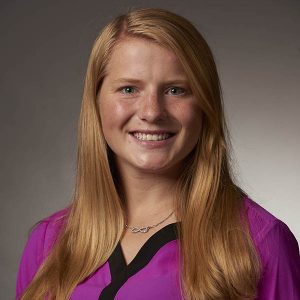Connor Jo Lewis has always been good at math and she knew that strength could lead to a greater understanding of the disease she was born with, cystic fibrosis (CF). “I’ve always wanted to use my skills and knowledge in math to help find a cure or advance treatment for CF,” says Lewis, a School of Public Health Biostatistics MS student whose brother also has CF, and, like Lewis, also has CF-related diabetes.

Discovering Biostats
As a math major at University of Minnesota-Morris, Lewis learned from a career counselor how the field of biostatistics could help her make change. “I learned how biostatisticians help advance therapies and treatments through clinical trials and data,” she says. “I was sold.”
To explore the field more, she participated in the SPH’s Summer Institute in Biostatistics (SIBS) and began working on data research with Antoinette Moran, division chief of pediatric endocrinology and diabetes at the University of Minnesota-Twin Cities and an expert in cystic fibrosis-related diabetes. In deciding where to go to graduate school, Lewis learned that SPH offered her the opportunity to keep working with Moran, so she enrolled in SPH’s Biostatistics MS program. “The School of Public Health was willing to work with me so I could keep doing CF research and experiment with that field,” says Lewis.
After spending her first year at UMN focusing on clinical data and expanding her statistics knowledge, Lewis was curious about what else she could do with her skills. In summer 2016, she interned with an agricultural technology company in San Francisco. “Statistics knowledge is needed everywhere,” she says. “And biostatistics not only builds these skills, but teaches you how to apply them and how to use them to answer questions.”
The Division of Biostatistics has also helped Lewis find her support system. While attending SIBS, nationally renowned clinical trials expert Professor Jim Neaton helped her move her fridge into a dorm. Her adviser Brad Carlin recruited her to come to SPH and has provided guidance with her thesis. She was captain of the division’s flag football team (which took first place among other UMN teams). And teachers like Assistant Professor David Vock helped confirm her niche. “Professor Vock’s class reminded me why I love statistics.”
Tackling Cystic Fibrosis
People with CF struggle with lung conditions and fatigue, but Lewis was always involved in multiple sports growing up — basketball and pole vaulting were her sports in college — and football has always been her favorite.
Not one to be deterred by her condition, she tried out for the Minnesota Vixen women’s tackle football team — one of the state’s two professional football teams — and opened the 2017 season in April on the starting line-up.
“The women are diverse, loving, caring, amazing individuals,” she says of her team, whose participants range in age from high schoolers to 50-year-olds. “The amount of support that I’ve received from these women is more than I have experienced on any team.”
Lewis graduated in spring 2017 and is now ready to further explore the biostatistics field. “People always ask what I’m going to do with a biostatistics degree. My response is, ‘What can’t I do?’” she says about being a biostatistician, which has been named one of the best careers by outlets such as CNN Money and Fortune. “There are so many options and everyone — from farmers to business owners to environmentalists — wants to know what’s going on with their data. Statisticians like me can help them.”
